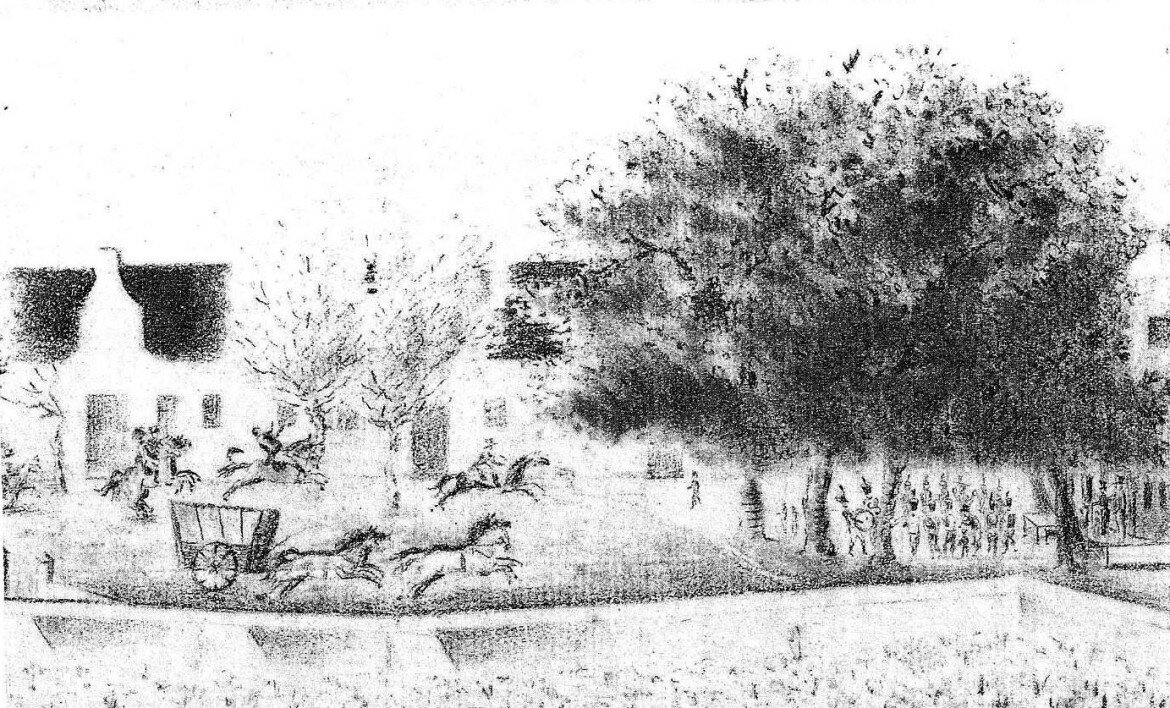
The above not very clear copy of a drawing, c 1800, seems to have represented a particular event at Bergvliet farm more than two hundred years ago. It suggests a dramatic moment in the life of one Constantia family which had rather expensive repercussions. A minor public display of private politics appeared most provocative to the then British governor of the Cape Colony and he over reacted. Research has not shown who the artist was nor whether the original drawing still exists.
Deeds Office records note that on April 20 1769 Petrus Michiel Eksteen became the owner of land once part of Simon van der Stel’s farm, Constantia. From that date the sub division became known as Bergvliet. Although large pieces of the property were sold off during the ownership of various Eksteens, resulting in a smaller farm, the Eksteen surname as owners of Bergvliet Farm was the same for approximately eighty years.
In 1783 Hendrik Oostwald Eksteen senior, Petrus Michiel’s second son, became the owner. He was a politically aware individual being a Cape Patriot: those citizens against the Dutch East India Company’s economic system. They favoured replacing the government because it was felt that the government did not have the farmers common interest at heart. The Patriots were attracted to and interested in the new political thinking and happenings in France. Unfortunately in 1798, by which time the Cape was under British rule, Eksteen’s interest in French politics drew the attention of the governor, Lord Macartney, when invitations to the forthcoming wedding of his daughter, Johanna Sibella Eksteen to TF Dreyer, were addressed to Citizen and Citizeness. It must be pointed out that the British were more than likely aware that both Eksteen and Dreyer had fought against the British occupation of 1795. They were thus not going to allow any possible insurrection to spread, no matter how trivial. Soldiers were sent to the farm to see that nothing occurred that might affect British rule at the Cape. Further, although Eksteen was forced to apologise for his actions Macartney still demanded £1000 security to see that he behaved himself and did not repeat his actions.
Lady Anne Barnard has referred to this event in various letters and, if she was the artist of the drawing, was perhaps attempting to depict the authorities in a display of power. It is not impossible that the owner may have expected a reaction from the governor. So he made preparations to be seen to be a polite host. The Bergvliet slave orchestra performed under the trees. The musicians were dressed in some kind of uniform – except for the man playing what looks like a flute. Standing to attention on the stoep are two neatly dressed men – presumably servants to attend to the needs of expected or unexpected guests. Then one notes a wagon drawn by two horses that appears to have approached the entrance at a very fast pace – surely not something a guest would do if making a social call. There are two soldiers fighting to control their steads. Maybe this was the artist’s way of suggesting intimidation? In front of the trees is a very small figure – presumably the host whom the authorities deemed to be in need of knowing who was “boss” in the land. A moment in history captured on canvas.
Time passed and understandably given the late 20th century’s need for houses, the farm Bergvliet ceased to exist. Nevertheless its history is an interesting one.
